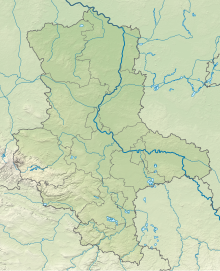Rogätzer slope ear muzzle
Coordinates: 52 ° 18 ′ 14 " N , 11 ° 45 ′ 22" E
Rogätzer Hang-Ohremündung is a nature reserve in the communities Rogätz and Loitsche-Heinrichsberg in the district of Börde in Saxony-Anhalt .
The nature reserve with the registration number NSG 0015 is 261 hectares in size. It is part of the FFH area "Elbaue south of Rogätz with the mouth of the ear" and the EU bird sanctuary "Elbaue Jerichow bird sanctuary". In the east it borders on the landscape protection area "Elbe Valley" in the area of the district Jerichower Land . The area has been under protection since 1999 (date of regulation: March 29, 1999). It replaces the “Rogötzer Hang” nature reserve, which was designated on May 1, 1961 and expanded on July 5, 1978. The responsible lower nature conservation authority is the district of Börde.
The nature reserve is located northeast of Wolmirstedt and northwest of Burg (near Magdeburg) in the Middle Elbe Biosphere Reserve . It represents the range of ear mouth into the Elbe and the Ohreniederung over a length of about four kilometers, the western part of the Labe region in this area and adjacent to the northwest, about 30 meters high steep slope of a moraine under protection.
The lowland , which here is subject to the natural flow dynamics of the Elbe and Ohre, is occupied by alternating wet alluvial grasslands, in which flood channels and oxbow lakes are embedded. Remnants of former clay mining areas have developed into near-natural still waters . In addition, alluvial forest remains , groups of trees and bushes can be found. There are extensive softwood meadows along the Ohre , which are among the largest and most valuable of their kind in Saxony-Anhalt. Here falter silver , breakage , wicker and almond willow . Hardwood meadows are only present as remnants. They consist of field and white elm , common ash , crab apple and black poplar .
Below the steep slope in the northwest of the nature reserve there is an oak , elm and hardwood alluvial forest with white elm and field maple. Moorish and springy locations are occupied by bird cherry-ash forest and, on a very small scale, by walzenseggen - alder quarry forest . The meadows areas are incorporated herein by angelica - Kohl thistle meadows and Auebereich the ear by Foxtail meadows and Silgen- Rasenschmielen characterized meadows.
At the foot of the steep slope a hill spring moor has formed, the peat thickness of which is more than 4.7 meters. A near-natural hornbeam- Ulmen slope forest grows on the steep slope. In places there are grasslands on the slope and on the dikes . On the treeless hillside areas it is predominantly Quecken -Pionierrasen and oat grass meadows, while on the dikes neglected grassland with Common Thrift and silver cinquefoil can be found. In flood channels and on oxbow lakes in the lowlands, reed beds and sedges settle down . a. with swaths of water , slender sedge , bank sedge , cane grass , calamus and foxtail grass groups .
In estuarine the ear in the same area there are several elongated islands with soft woods and vegetation-free mudflats.
The nature reserve is characterized by its rich bird fauna . So breed in the nature reserve u. a. Little moorhen , shelduck , shoveler , teal duck , fieldfare , sandpiper , sparrowhawk , puffy tit , whorl , hoopoe and kingfisher . White and black storks can be found as food guests. The nature reserve is also important as a resting and wintering area for ducks and Limikolen . Also dragonflies are frequent, u. a. Banded demoiselle , southern rush damsel and southern mosaic damsel . Elbe beavers and otters are native to the nature reserve .
The undergrowth trench, through which this area is drained, runs below the steep slope.
Web links
Individual evidence
- ^ Order No. 1 on nature reserves , Law Gazette of the German Democratic Republic, May 4, 1961. The Minister for Agriculture, Registration and Forestry, March 30, 1961. Accessed March 14, 2014.
- ^ Announcement of the resolution of the Magdeburg District Assembly of July 5, 1978 on the declaration of nine parts of the landscape as nature reserves, the expansion of four existing nature reserves and the cancellation of the declaration of protection from a nature reserve , Council of the Magdeburg District, Forestry Department (PDF, 14.6 kB ). Retrieved April 18, 2018.


